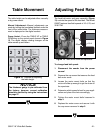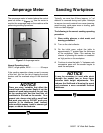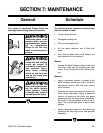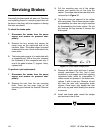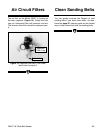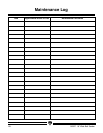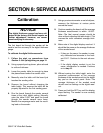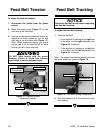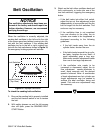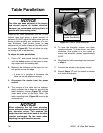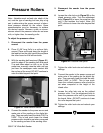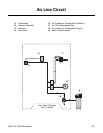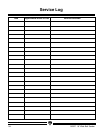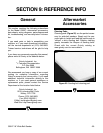
G0527 18" Wide Belt Sander -29-
Belt Oscillation
NOTICE
The oscillation adjustments have been per-
formed at the factory and should require no
further attention. However, we recommend
verifying the settings.
Figure 19. Improper oscillation.
Sanding Belt
Limit Switches
Sander Outline
(Top View)
When the oscillation is correctly adjusted, the
sanding belt oscillates to the left and to the right
at the same speed and without coming into con-
tact with the limit switches. If the sanding belt
oscillates too far to the left or right, making con-
tact with the limit switches as shown in Figure 19,
the emergency braking system will activate.
To check the sanding belt oscillation:
1. Be sure the sanding belt is properly installed
and the belt tension switch is set to tension
the belt.
2. With safety glasses on and the left access
door still open, press the SANDING BELT
START Button.
3. Watch as the belt either oscillates back and
forth continuously, or tracks into one of the
two limit switches, triggering the emergency
brake.
— If the belt tracks into either limit switch,
adjust the two air flow adjustment knobs
independently of one another until the the
belt no longer hits the limit switches. Trial
and error may be necessary.
— If the oscillation time is not consistent
from one direction to the other, the air
cylinder arm needs to be lengthened or
shortened according to the following
guidelines:
• If the belt tracks away from the air
cylinder faster, shorten the arm.
• If the belts tracks towards the air cylin-
der faster, lengthen the arm. Note—A
small adjustment goes a long way.
Make many smaller adjustments rather
than one or two large adjustments.
— If the oscillation rate needs to be
increased or decreased, adjust the air
flow adjustment counter-clockwise in
small, equal amounts until the desired
speed is achieved. Note—A combination
of knob adjustments and air cylinder arm
length adjustments may be needed to
achieve the ideal oscillation timing and
speed. Trial and error adjustments may
be necessary.



